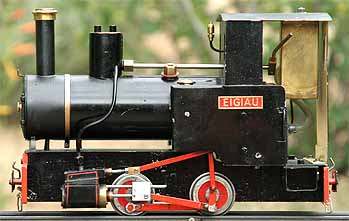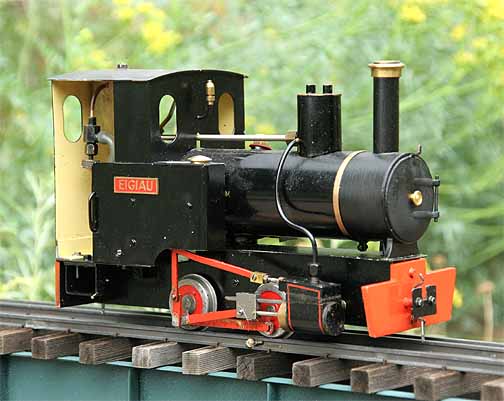
Back to Loco of the Month homepage
Back to Sidestreet Bannerworks
.
July 2005
Archangel's Eigiau
by Marc Horovitz

Eigiau was built by the German firm of Orenstein & Koppel in 1912 as works Nº 5668. The little engine weighed 6.1 tons and was built to run on 600mm track (23.62 inches). It was evidently purchased new by Charles L. Warren (who was he?), and passed through several hands over the years including, among others, Aluminium Corporation Ltd, Penrhyn Slate Quarries, and Alan Bloom's Bressingham Gardens. The engine is alive and well today, restored and working at the Bredgar & Wormshill Light Railway in Britain. Here is a link to the railway and some photos of the prototype.
The model
As with many Archangel models, this one is a rough approximation of the prototype. Its wheels are solid, where the prototype's are spoked. The cab side sheets are a little different, as is the slant of the cylinders. However, the model does manage to capture some of the flavor of the original.
This is a fairly simple engine, but it has some interesting features. It's gas fired, with a large tank suspended beneath the cab roof. Access to the filler valve is through the roof. The throttle is under the steam-dome cover, actuated from the cab via a long rod. Also in the steam dome is the safety valve and an odd little displacement lubricator. On the left side of the boiler, near the top, is a Goodall-type filler valve. There's no water glass, so filling the boiler while under pressure is a matter of trial and error.
One of the most interesting features of this model is its prototypically correct Koppel valve gear. Externally, this resembles Hackworth, but has no sliding link. Instead, it has a series of levers (concealed by the dummy side tanks) reminiscent of Baker valve gear. This is controlled from the cab by a simple control arm that competes for space with the gas supply line.
The run
After preparing the engine in the usual manner, I lit the fire. It ignited instantly and flashed back into the flue in a satisfying manner. The gas jet is probably 1/4" or more from the flue end, with nothing in between. The gas is just expected to leap the gap, which it does with alacrity. However, this makes the fire particularly susceptible to the breeze, and this was a breezy day. The gas control valve is on the right side of the cab. It's a small knob, awkwardly placed. I lost the fire several times in an attempt to throttle it down. In the end, it would only go so low before it went out. When running, this caused the safety to blow almost constantly.
Once pressure was up, which didn't take long given the small boiler, I put the engine in gear (pull the lever back to go forward, and vice-versa) and opened the throttle. The cylinders a very small and it took some prodding to clear them of condensate. Once clear, though, the engine moved smoothly away. It is a sweet runner, easily controllable with the long throttle lever, accessed from the left side of the cab. Keeping it going at a walking pace was no problem, although if it got out of hand, its performance was extremely lively.
The run lasted perhaps 20 minutes or so, with the engine running light, lap after lap, unattended. It's a wonderful little thing, unlike any other model 0-4-0 in many respects. I've no idea how many of these engines Archangel made -- not a lot, I'm sure. Personally, I know of only one other, although certainly there must be more. Should you ever run across one, snap it up. It's a keeper.
|
|
|
| Builder | Archangel (Great Britain) |
| Date built | Unknown (mid 1980s?) |
| Gauge | 0 (32mm) |
| Scale | 16mm = 1'0" |
| Boiler | Single flue |
| Fittings | Safety valve, throttle, Goodall-type filler valve |
| Fuel | Butane |
| Blow-off pressure | 45 psi (estimated) |
| Cylinders | Two, double acting, D-valve |
| Reversing gear | Koppel valve gear |
| Lubricator | Displacement |
| Weight | 2 lbs., 14 oz. |
| Dimensions | Length over end beams, 8"; width, 3-1/8"; height, 5-5/8" |


This locomotive captures much of the charm of the prototype. While it is a commercial model, it retains the character of a handmade piece, which it certainly is. The steam dome is made of sheet metal. It comes off to reveal the safety valve, throttle valve, and lubricator. Another interesting feature is that the cylinders are not placed directly beneath the stack.
.



In the left side of the cab is the throttle lever (near the roof). There is no water glass or pressure gauge, although there is a plug on the backhead that could be used for a gauge.
.
Through the right-side door can be seen the gas tank, suspended from the ceiling. The awkwardly placed control valve is next to it. The red wire is the reversing lever. Note the gas jet aimed at the flue.
.

Right: The sheet-metal steam dome, once removed, reveals the all-in-one throttle valve, safety valve, and lubricator. The latter is the tiny space beneath the hex screw. Strange, but it seems to work OK.
.

Left: The unusual Koppel valve gear is made up entirely of rods -- no sliding links. Unfortunately, the most interesting part is hidden in the side tank. Note the inclined valve.
.
Right: There is little to be seen under this engine. Just the plain, steel frames with the axles running through and the cylinders bolted on. The exhaust lines run forward to the stack.
.


Any way you look at it, Eigiau is an attractive model. Its plain lines and simple construction reflect its industrial heritage. The oddly shaped front beam only adds to its charm.
.
Back to Loco of the Month home page
Back to Sidestreet Bannerworks home page
This page and its contents
Copyright Sidestreet Bannerworks, 2005
.